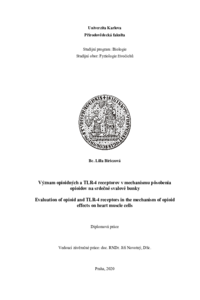Význam opioidných a TLR-4 receptorov v mechanismu pôsobenia opioidov na srdečné svalové bunky
Evaluation of opioid and TLR-4 receptors in the mechanism of opioid effects on heart muscle cells
Význam opioidních a TLR-4 receptorů v mechanismu působení opioidů na srdeční svalové buňky
diplomová práce (OBHÁJENO)

Zobrazit/
Trvalý odkaz
http://hdl.handle.net/20.500.11956/121961Identifikátory
SIS: 195347
Kolekce
- Kvalifikační práce [21484]
Autor
Vedoucí práce
Oponent práce
Alánová, Petra
Fakulta / součást
Přírodovědecká fakulta
Obor
Fyziologie živočichů
Katedra / ústav / klinika
Katedra fyziologie
Datum obhajoby
10. 9. 2020
Nakladatel
Univerzita Karlova, Přírodovědecká fakultaJazyk
Slovenština
Známka
Výborně
Klíčová slova (česky)
Opioidní receptory, TLR-4 receptor, H9c2 a HL-1 buňky, srdceKlíčová slova (anglicky)
Opioid receptors, TLR-4 receptor, H9c2 and HL-1 cells, heartV literatúre bolo poukázané, že aktivácia opioidných receptorov napodobňuje fenomén ischemického preconditioningu, ktorý chráni srdce pred rozvinutím infarktu.Toll-like receptor 4 (TLR-4) počas infarktu stimuluje produkciu cytokínov, ktoré spôsobia zápal a vedú k poškodeniu tkaniva srdca. Našim cieľom bolo preskúmať vplyv morfínu in vitro na viabilitu a oxidatívny stav v H9c2 bunkách (potkanie kardiomyoblasty) a rolu TLR-4 počas oxidatívneho stresu. Naše výsledky dokázali, že podávanie morfínu pred vyvolaním oxidatívneho stresu pomocou tert- butylhydroperoxidu (t-BHP), 2,2'-bipyridylu (BP) a lipopolysacharidu (LPS) pôsobí protektívne na viabilitu H9c2 buniek a výrazne zníži produkciu kyslíkových radikálov. Protektívne účinky morfínu vymizli po podaní naloxonu. Potlačenie funkce TLR-4 inhibítorom TAK-242 a pomocou RNA interferencie viedlo k miernemu zvýšeniu viability buniek a k výraznému potlačeniu produkcie kyslíkových radikálov po pôsobení t-BHP a BP. V dôsledku potlačenia funkce TLR-4, viabilita buniek bola výrazne zvýšená po aplikácie LPS. Najvýznamnejší efekt na zachovanie viability a zmiernenie oxidačného stresu mal súčasné podávanie naloxonu a potlačenie expresie TLR-4. Pomocou Western blotu sme zistili, že oxidatívny stres vyvolaný pomocou t-BHP, BP a LPS vedie k zvýšeniu expresie Bax,...
It has been reported that opioid receptor activation mimics ischemic preconditioning, which may protect the heart from the development of infarction. Toll-like receptor 4 (TLR-4) during infarction stimulates cytokine production leading to inflammation and injury of the heart tissue. Our aim was to study the effect of morphine in vitro on the viability and oxidative state of H9c2 cells (rat cardiomyoblasts) and the role of TLR-4 during oxidative stress. Our experiments showed that pretreatment with morphine before tert-butylhydroperoxide (t-BHP)-, 2,2'-bipyridyl (BP)- and lipopolysaccharide (LPS)-induced oxidative stess had protective effect on the viability of H9c2 cells and markedly reduced the production of reactive oxygen species (ROS). The protective effect of morphine was diminished after naloxone treatment, which confirms the role of opioid receptors in preconditioning. TLR-4 inhibition by TAK-242 pretreatment and silencing TLR-4 by RNA interference resulted in a partial increase in cell viability but significant attenuation of ROS production after t-BHP and BP treatment. The action of LPS was reduced in response to TLR-4 silencing. Interestingly, naloxone pretreatment and suppression of TLR-4 markedly alleviated oxidative stress and resulted in a significant improvement of cell viability. We...
